Akiko Aizawa
LLM-as-a-Judge: Reassessing the Performance of LLMs in Extractive QA
Apr 16, 2025Abstract:Extractive reading comprehension question answering (QA) datasets are typically evaluated using Exact Match (EM) and F1-score, but these metrics often fail to fully capture model performance. With the success of large language models (LLMs), they have been employed in various tasks, including serving as judges (LLM-as-a-judge). In this paper, we reassess the performance of QA models using LLM-as-a-judge across four reading comprehension QA datasets. We examine different families of LLMs and various answer types to evaluate the effectiveness of LLM-as-a-judge in these tasks. Our results show that LLM-as-a-judge is highly correlated with human judgments and can replace traditional EM/F1 metrics. By using LLM-as-a-judge, the correlation with human judgments improves significantly, from 0.17 (EM) and 0.36 (F1-score) to 0.85. These findings confirm that EM and F1 metrics underestimate the true performance of the QA models. While LLM-as-a-judge is not perfect for more difficult answer types (e.g., job), it still outperforms EM/F1, and we observe no bias issues, such as self-preference, when the same model is used for both the QA and judgment tasks.
Harnessing PDF Data for Improving Japanese Large Multimodal Models
Feb 20, 2025Abstract:Large Multimodal Models (LMMs) have demonstrated strong performance in English, but their effectiveness in Japanese remains limited due to the lack of high-quality training data. Current Japanese LMMs often rely on translated English datasets, restricting their ability to capture Japan-specific cultural knowledge. To address this, we explore the potential of Japanese PDF data as a training resource, an area that remains largely underutilized. We introduce a fully automated pipeline that leverages pretrained models to extract image-text pairs from PDFs through layout analysis, OCR, and vision-language pairing, removing the need for manual annotation. Additionally, we construct instruction data from extracted image-text pairs to enrich the training data. To evaluate the effectiveness of PDF-derived data, we train Japanese LMMs and assess their performance on the Japanese LMM Benchmark. Our results demonstrate substantial improvements, with performance gains ranging from 3.9% to 13.8% on Heron-Bench. Further analysis highlights the impact of PDF-derived data on various factors, such as model size and language models, reinforcing its value as a multimodal resource for Japanese LMMs. We plan to make the source code and data publicly available upon acceptance.
ParaRev: Building a dataset for Scientific Paragraph Revision annotated with revision instruction
Jan 09, 2025Abstract:Revision is a crucial step in scientific writing, where authors refine their work to improve clarity, structure, and academic quality. Existing approaches to automated writing assistance often focus on sentence-level revisions, which fail to capture the broader context needed for effective modification. In this paper, we explore the impact of shifting from sentence-level to paragraph-level scope for the task of scientific text revision. The paragraph level definition of the task allows for more meaningful changes, and is guided by detailed revision instructions rather than general ones. To support this task, we introduce ParaRev, the first dataset of revised scientific paragraphs with an evaluation subset manually annotated with revision instructions. Our experiments demonstrate that using detailed instructions significantly improves the quality of automated revisions compared to general approaches, no matter the model or the metric considered.
The Promises and Pitfalls of LLM Annotations in Dataset Labeling: a Case Study on Media Bias Detection
Nov 17, 2024Abstract:High annotation costs from hiring or crowdsourcing complicate the creation of large, high-quality datasets needed for training reliable text classifiers. Recent research suggests using Large Language Models (LLMs) to automate the annotation process, reducing these costs while maintaining data quality. LLMs have shown promising results in annotating downstream tasks like hate speech detection and political framing. Building on the success in these areas, this study investigates whether LLMs are viable for annotating the complex task of media bias detection and whether a downstream media bias classifier can be trained on such data. We create annolexical, the first large-scale dataset for media bias classification with over 48000 synthetically annotated examples. Our classifier, fine-tuned on this dataset, surpasses all of the annotator LLMs by 5-9 percent in Matthews Correlation Coefficient (MCC) and performs close to or outperforms the model trained on human-labeled data when evaluated on two media bias benchmark datasets (BABE and BASIL). This study demonstrates how our approach significantly reduces the cost of dataset creation in the media bias domain and, by extension, the development of classifiers, while our subsequent behavioral stress-testing reveals some of its current limitations and trade-offs.
Self-Compositional Data Augmentation for Scientific Keyphrase Generation
Nov 05, 2024Abstract:State-of-the-art models for keyphrase generation require large amounts of training data to achieve good performance. However, obtaining keyphrase-labeled documents can be challenging and costly. To address this issue, we present a self-compositional data augmentation method. More specifically, we measure the relatedness of training documents based on their shared keyphrases, and combine similar documents to generate synthetic samples. The advantage of our method lies in its ability to create additional training samples that keep domain coherence, without relying on external data or resources. Our results on multiple datasets spanning three different domains, demonstrate that our method consistently improves keyphrase generation. A qualitative analysis of the generated keyphrases for the Computer Science domain confirms this improvement towards their representativity property.
An Encoding--Searching Separation Perspective on Bi-Encoder Neural Search
Aug 02, 2024Abstract:This paper reviews, analyzes, and proposes a new perspective on the bi-encoder architecture for neural search. While the bi-encoder architecture is widely used due to its simplicity and scalability at test time, it has some notable issues such as low performance on seen datasets and weak zero-shot performance on new datasets. In this paper, we analyze these issues and summarize two main critiques: the encoding information bottleneck problem and limitations of the basic assumption of embedding search. We then construct a thought experiment to logically analyze the encoding and searching operations and challenge the basic assumption of embedding search. Building on these observations, we propose a new perspective on the bi-encoder architecture called the \textit{encoding--searching separation} perspective, which conceptually and practically separates the encoding and searching operations. This new perspective is applied to explain the root cause of the identified issues and discuss ways to mitigate the problems. Finally, we discuss the implications of the ideas underlying the new perspective, the design surface that it exposes and the potential research directions arising from it.
LLM-jp: A Cross-organizational Project for the Research and Development of Fully Open Japanese LLMs
Jul 04, 2024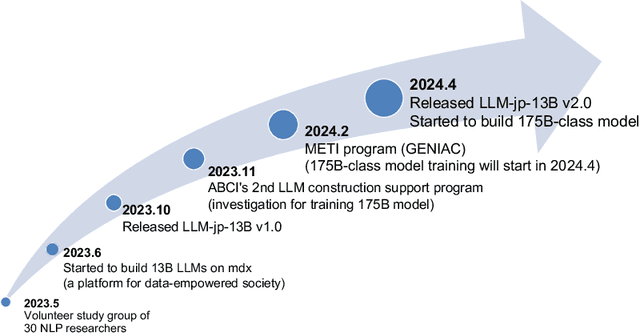
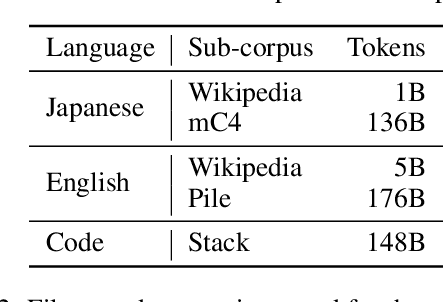


Abstract:This paper introduces LLM-jp, a cross-organizational project for the research and development of Japanese large language models (LLMs). LLM-jp aims to develop open-source and strong Japanese LLMs, and as of this writing, more than 1,500 participants from academia and industry are working together for this purpose. This paper presents the background of the establishment of LLM-jp, summaries of its activities, and technical reports on the LLMs developed by LLM-jp. For the latest activities, visit https://llm-jp.nii.ac.jp/en/.
MoreHopQA: More Than Multi-hop Reasoning
Jun 19, 2024Abstract:Most existing multi-hop datasets are extractive answer datasets, where the answers to the questions can be extracted directly from the provided context. This often leads models to use heuristics or shortcuts instead of performing true multi-hop reasoning. In this paper, we propose a new multi-hop dataset, MoreHopQA, which shifts from extractive to generative answers. Our dataset is created by utilizing three existing multi-hop datasets: HotpotQA, 2WikiMultihopQA, and MuSiQue. Instead of relying solely on factual reasoning, we enhance the existing multi-hop questions by adding another layer of questioning that involves one, two, or all three of the following types of reasoning: commonsense, arithmetic, and symbolic. Our dataset is created through a semi-automated process, resulting in a dataset with 1,118 samples that have undergone human verification. We then use our dataset to evaluate five different large language models: Mistral 7B, Gemma 7B, Llama 3 (8B and 70B), and GPT-4. We also design various cases to analyze the reasoning steps in the question-answering process. Our results show that models perform well on initial multi-hop questions but struggle with our extended questions, indicating that our dataset is more challenging than previous ones. Our analysis of question decomposition reveals that although models can correctly answer questions, only a portion - 38.7% for GPT-4 and 33.4% for Llama3-70B - achieve perfect reasoning, where all corresponding sub-questions are answered correctly. Evaluation code and data are available at https://github.com/Alab-NII/morehopqa
Eigenpruning
Apr 04, 2024


Abstract:We introduce eigenpruning, a method that removes singular values from weight matrices in an LLM to improve its performance in a particular task. This method is inspired by interpretability methods designed to automatically find subnetworks of a model which solve a specific task. In our tests, the pruned model outperforms the original model by a large margin, while only requiring minimal computation to prune the weight matrices. In the case of a small synthetic task in integer multiplication, the Phi-2 model can improve its accuracy in the test set from 13.75% to 97.50%. Interestingly, these results seem to indicate the existence of a computation path that can solve the task very effectively, but it was not being used by the original model. Finally, we plan to open-source our implementation in the camera-ready version of our work.
Can LLMs Master Math? Investigating Large Language Models on Math Stack Exchange
Mar 30, 2024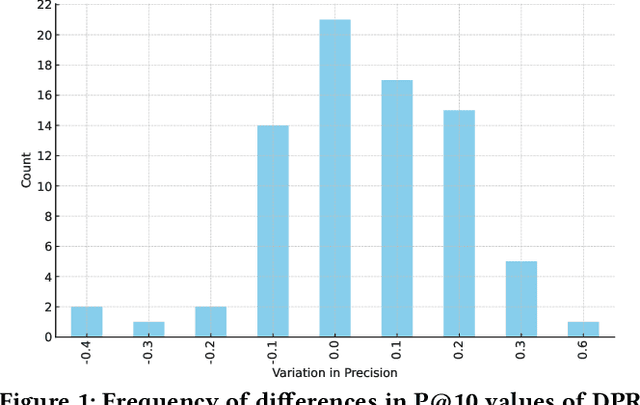
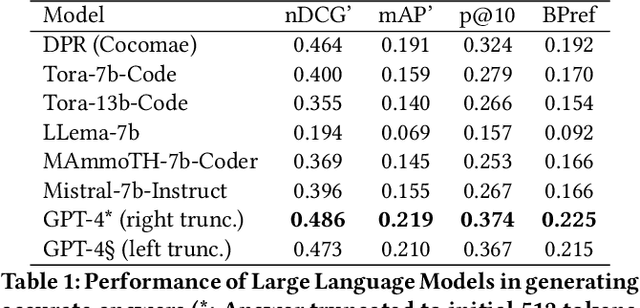
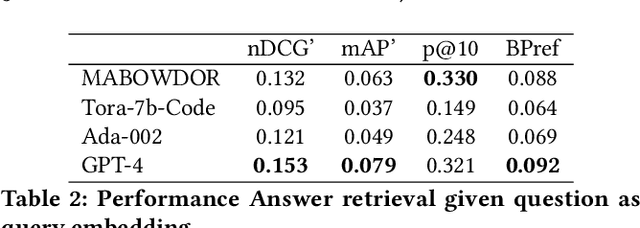
Abstract:Large Language Models (LLMs) have demonstrated exceptional capabilities in various natural language tasks, often achieving performances that surpass those of humans. Despite these advancements, the domain of mathematics presents a distinctive challenge, primarily due to its specialized structure and the precision it demands. In this study, we adopted a two-step approach for investigating the proficiency of LLMs in answering mathematical questions. First, we employ the most effective LLMs, as identified by their performance on math question-answer benchmarks, to generate answers to 78 questions from the Math Stack Exchange (MSE). Second, a case analysis is conducted on the LLM that showed the highest performance, focusing on the quality and accuracy of its answers through manual evaluation. We found that GPT-4 performs best (nDCG of 0.48 and P@10 of 0.37) amongst existing LLMs fine-tuned for answering mathematics questions and outperforms the current best approach on ArqMATH3 Task1, considering P@10. Our Case analysis indicates that while the GPT-4 can generate relevant responses in certain instances, it does not consistently answer all questions accurately. This paper explores the current limitations of LLMs in navigating complex mathematical problem-solving. Through case analysis, we shed light on the gaps in LLM capabilities within mathematics, thereby setting the stage for future research and advancements in AI-driven mathematical reasoning. We make our code and findings publicly available for research: \url{https://github.com/gipplab/LLM-Investig-MathStackExchange}
 Add to Chrome
Add to Chrome Add to Firefox
Add to Firefox Add to Edge
Add to Edge